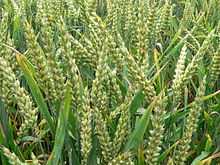Rabi crop
Rabi crops or Rabi harvest(Hindi: रबी, Urdu: رَبِیع, Punjabi: ਰੱਬੀ) refers to agricultural crops sown in winter and harvested in the spring. The term is derived from the Arabic word for "spring", which is used in the Indian subcontinent. It is the spring harvest (also known as the "winter crop") in Indian subcontinent.
The rabi crops are grown between the months mid November to April. The main rabi crop is wheat.
The water that has percolated in the ground during the rains is main source of water for these crops. Rabi crops require irrigation.
So a good or bountiful rain may tend to spoil the Kharif crops but it is good for Rabi crops.
These crops are taken after the departure of monsoon rains. The seeds are sown after the rains have gone and harvesting begins in April/May.
Major Rabi crop is wheat in India followed by barley, mustard, sesame and peas. (They are harvested early as they are ready early). So Indian Markets are flooded with Green Peas from January to March (Peak is Feb.)[1]
The rabi season starts with the onset of north-east monsoon in October. Many crops are cultivated in both kharif and rabi seasons. The agriculture crops produced in India are seasonal in nature and highly dependent on these two monsoons.[2]
Examples of Rabi Crops: Wheat, Gram, Pea, Mustard, Linseed, Barley,
References
- ↑ Balfour, Edward (1885). The Cyclopaedia of India and of Eastern and Southern Asia (3 ed.). London: Bernard Quaritch. p. 331.
- ↑ Sowing time of Rabi & Kharif crop | agropedia
External links
- E2kB Farming - Rabi, Kharif and Zayad Crops - Animal Husbandry - Fishery
- Location
- India: 2003/04 Rabi Crop Assessment, US Department of Agriculture
- Pakistan Agriculture Information

